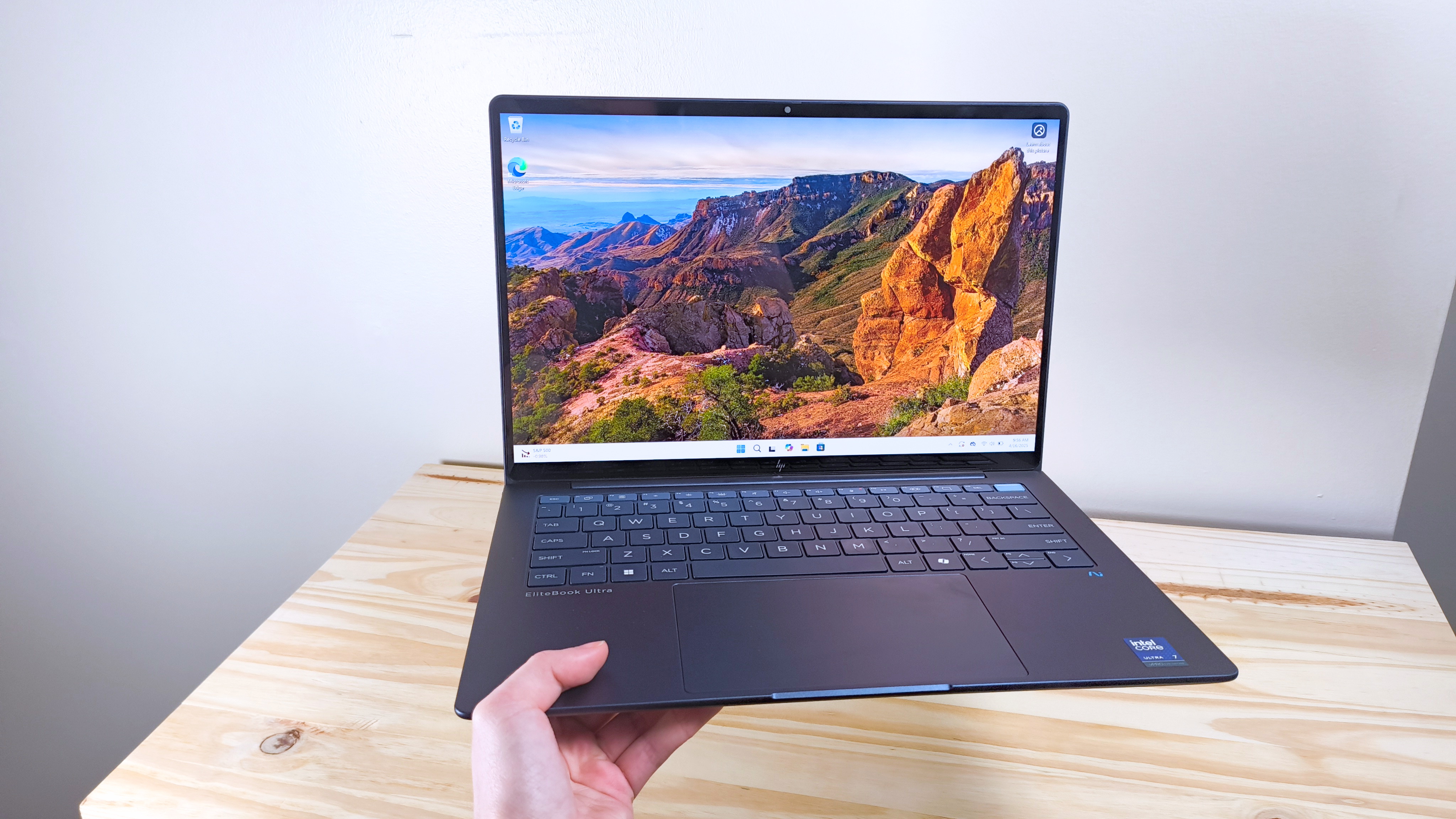Laptop Mag Verdict
This lightweight notebook offers good performance and a stylish design but the ergonomics could be better.
Pros
- +
Attractive design
- +
Fast performance for its class
- +
Slightly less expensive than competing models
- +
Strong wireless range
- +
HDMI output
Cons
- -
Stiff, narrow touch button
- -
Long boot time
- -
Weak speakers
Why you can trust Laptop Mag
Although Toshiba made a late (but worthy) entry into the netbook market, the company has jumped right into the Ultra-Low Voltage (ULV) category: affordable thin-and-lights that are slightly larger and more powerful than mini-notebooks. The $709 Satellite T135-S1310WH, a 13.3-inch configuration from the company's new T Series of ULV notebooks, is one of the most stylish we've seen, and offers faster performance than many of its more expensive competitors. We're not fans of the single touchpad button, and we wish the speakers were louder, but overall the T135 is a good value.
Design
Toshiba's Satellite T Series notebooks are a good looking bunch. Available in black, red, and white, they all have a subtle pattern, similar to houndstooth, which spreads across the lid and extends onto the keyboard deck and palm rest. Even the touchpad bears that pattern (although it has a textured finish), while the rest of the machine is positively glossy. Because of this pattern, fingerprints remain more or less hidden. Coupled with metal accents on and around the touch button, this design keeps the machine looking a bit more expensive (and rightfully so) than, say, a netbook.
At 3.8 pounds, the T135 is about as light as you'd expect a ULV system to be. That is to say, it's light and slim enough to hold in one hand. Even though the six-cell battery creates a slight bulge at the bottom, it was still a cinch to carry, especially from room to room; however, after toting it around in our shoulder bag for a few hours, we experienced some mild discomfort.
Keyboard and Trackpad
Despite being 12.7 x 8.8 x 1.4 inches--in other words, a full-sized notebook--the T135's keyboard feels a bit cramped. Toshiba could have easily fixed this by extending the keyboard from edge to edge, instead of leaving almost an inch on either end of the deck. The keys themselves are flat and arranged close together, with the right Shift key slightly shrunken and the four arrows wedged into the lower right corner--almost an afterthought.
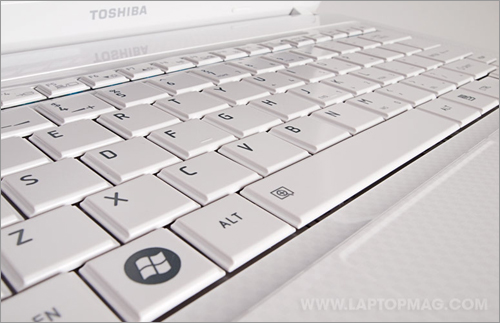
Click to enlarge
Typing on the T135 takes a little bit of getting used to; we initially scored 77 words per minute on the Ten Thumbs Typing Tutor, which isn't bad, but seems weak compared to the 88 wpm we've scored on our desktop keyboard, and even the 80+ wpm we routinely score using other notebook keyboards.
Unfortunately, the T135 doesn't borrow the two large touch buttons we loved so much in the NB205, the company's flagship, Editors' Choice-winning netbook. Instead, it has a single narrow touch button. Although the metal design--similar to that on the Satellite U505--looks sleek, it can feel stiff if you accidentally press the center of the button, as opposed to the left and right edges.
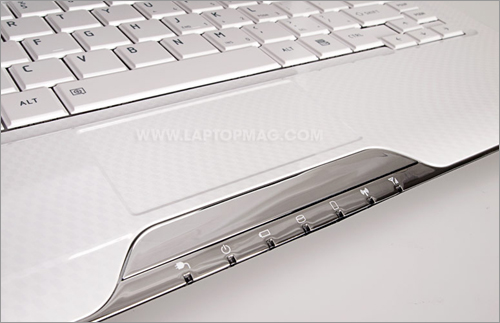
Click to enlarge
As for the touchpad, it supports multitouch gestures, such as pinching and zooming, and is fairly responsive, but the short 3.2 x 1.6-inch size isn't ideal for utilizing this functionality.
Display and Sound
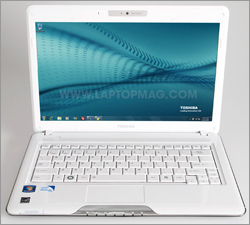
Click to enlarge
The 13.3-inch, 1366 x 768-pixel resolution screen is perfect for Web surfing and composing documents and e-mails. We were impressed by how bright the display was, even while surfing unplugged (at which point the power management settings automatically knock the brightness down from its maximum to a more median setting). The YouTube clips we watched at full screen also looked sharp.
We were less impressed by the speakers. When we played Green Day's "American Idiot" on Slacker Personal Radio, we were surprised with just how very little volume the T135 produces, though at least the sound was clear.
Ports and Webcam
The T135, like other 13.3-inch ULV notebooks, has no optical drive. It does, however, have HDMI output, along with a standard-definition VGA port. It also has a generous three USB ports, an Ethernet jack, headphone and mic ports, and a 5-in-1 memory card reader. Much of the left side is taken up by the vent. We were pleasantly surprised that, even after using the notebook for a while, it remained cool or lukewarm to the touch, but never hot--a common problem with fanless ULV systems.

Click to enlarge
The 1.3-megapixel webcam's VGA video wasn't particularly sharp, nor are the colors vibrant, but the lighting was bright enough, and our voice synced up with our lips as we spoke. The sound was accurate, too, if on the weak side. Since the smoothness is its most redeeming quality, we don't recommend taking still photos: you'll be stuck with grainy quality and pallid colors.
Users can also set up face recognition, a security measure that ensures the computer will only boot into Windows if the camera first identifies the person using the computer. Setting this up was easy, but tedious: you must align your face with a cartoonish on-screen one, and spend a couple minutes rotating your head up and down and from side to side until the program develops a full enough picture to register your face with. It took us two tries to get this right, although we've nailed it on the first try with other Toshiba notebooks in the past.
Performance
At $709, the T135 sometimes outperforms other ULV notebooks that are $100 to $200 more expensive. Its 1.3-GHz Intel Pentium SU4100 CPU, 4GB of RAM, and 64-bit Windows 7 Home Premium added up to a score of 2,701 on PCMark Vantage, a Windows performance benchmark. This showing is about 40 points shy of the ultraportable category average, but still beats the $899 Acer Aspire Timeline 3810T (2,678), $799 ASUS UL30A (2,442), and the $749 Lenovo IdeaPad U350 (1,504).
The T135's 5,400-rpm, 320GB hard drive is slightly slower than these other notebooks', as well as other ultraportables in general. It transferred a 4.97GB mixed-media folder at a rate of 19.3 MBps, whereas the category average is 19.5 MBps. The UL30A, meanwhile, held a pace of 23.2 MBps, while the 3810T completed the test at a rate of 24.8 MBps. Out of the box, the T135 booted in a slow 1:15, but once we removed the unwanted bundled software (more on that later) the startup time dropped to a fast 47 seconds.
When it came to everyday speed, we had no problem bouncing between several open tabs in Internet Explorer, including reading e-mails, refreshing our Twitter feed, and searching for products in an online store. To match its strong PCMark Vantage score, the T135 managed to transcode a five-minute-and-five-second MPEG-4 clip to AVI in just 11:41, whereas the average ultraportable takes a sluggish 15:19. While the dual-core UL30A finished in an impressive 10:55, single-core ULV systems generally choke on this task. The 3810T, for example, took 22:18, almost twice the time of the T135.
Graphics
The T135's integrated Intel 4 Series Express Chipset card scored 718 on 3DMark06, a gaming benchmark, which is about 110 points below the ultraportable category average. For a ULV laptop, however, this score is about average. While the UL30A, for one, bested it with a score of 760 (equally useless for serious gamers), it's still an improvement over scores from the 3810T (698) and the U350 (604).
Forget anything other than casual games on a system like this: it only managed frame rates of 4 (1024 x 768) and 2 (1366 x 768) frames per second in Far Cry 2, a graphically demanding game. That's par for the course: we observed almost identical numbers in competing ULV notebooks from Acer, ASUS, and Lenovo.
In a situation more akin to what users are likely to attempt, we loaded Google Earth on our T135 and observed how smooth a ride we could get "flying" from one location on the map to another. It took a bumpy 10 seconds to arrive at the Chrysler Building in New York City, and another 10 for the picture and 3D buildings to fully load and come into focus.
Battery Life and Wi-Fi
The T135's six-cell battery lasted 7 hours and 23 minutes on the LAPTOP Battery Test. While that's far longer than the ultraportable category average, which is just under 5 hours, it's still not quite as long as the battery life offered by other ULV systems, all of whose mission is to deliver the longest battery life possible. The ASUS UL30A, for instance, lasted 9:55, while the Acer Timeline 3810T made it to 8:05.
The Realtek 802.11n radio delivered better-than-average performance: its throughput of 23.2 Mbps at 15 feet bests the ultraportable category average, as well as such systems as the Acer 3810T and the Lenovo IdeaPad U350. This configuration additionally comes with Bluetooth 2.1.
Software and Warranty
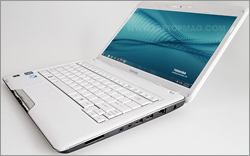
Click to enlarge
The T135 ships with a fair share of software, initially resulting in long boot times. This selection includes Google Toolbar for Internet Explorer, a trial of Microsoft Office Home and Student 2007 (including a compatibility pack, activation assistant, and PowerPoint viewer), and a trial of Norton Internet Security.
The notebook comes with a one-year warranty and includes 24/7, toll-free phone support. To read about how Toshiba fared in our annual notebook tech support showdown, click here.
Configuration Options
The S1310WH configuration we tested costs $699 if you buy it in black, but if you get in red or white (the color of our unit) the cost rises to $709. Another configuration, the S1300, has the same specs with the exception of its processor, which is a slower 1.3-GHz Intel Pentium SU2700. If you go for this configuration, expect to pay $599 for it in black, and $609 for the red or white versions.
Verdict
There's a lot to like about the Toshiba Satellite T135-S1310WH. For slightly less money than many of its competitors, it offers better performance and style. The T135 isn't perfect, however; we're not crazy about the keyboard and touchpad, and while the battery life is long, other ULV notebooks last even longer. Overall, we prefer the ASUS UL30A because it lasts almost 10 hours on a charge, and offers better ergonomics and 180GB of more storage space for even less money ($679 street price). Nevertheless, the T135 is a strong choice for people looking for an inexpensive ultraportable.
Toshiba Satellite T135 Specs
| Bluetooth | Bluetooth 2.1 |
| Brand | Toshiba |
| CPU | 1.3-GHz Intel Pentium SU4100 |
| Card Slots | 5-1 card reader |
| Company Website | http://www.toshibadirect.com |
| Display Size | 13.3 |
| Graphics Card | Intel GMA 4500MHD |
| Hard Drive Size | 320GB |
| Hard Drive Speed | 5,400rpm |
| Native Resolution | 1366x768 |
| Operating System | MS Windows 7 Home Premium (64-bit) |
| Ports (excluding USB) | Microphone, Headphone, HDMI, Ethernet, VGA |
| RAM | 4GB |
| RAM Upgradable to | 8GB |
| Size | 12.7 x 8.8 x 1.4 inches |
| USB Ports | 3 |
| Video Memory | 132MB |
| Warranty/Support | One-year limited/24/7 toll-free phone |
| Weight | 3.8 pounds |
| Wi-Fi | 802.11n |
